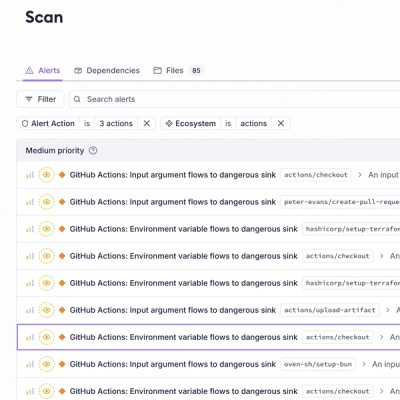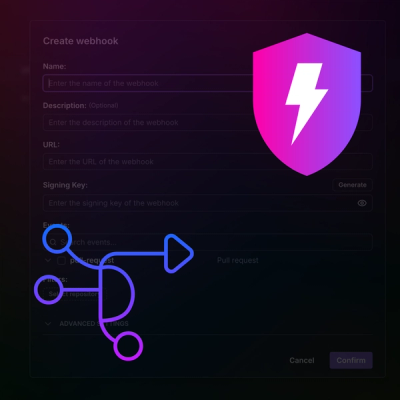
Product
Introducing GitHub Actions Scanning Support
Detect malware, unsafe data flows, and license issues in GitHub Actions with Socket’s new workflow scanning support.
use-context-selector
Advanced tools
React useContextSelector hook in userland
React Context and useContext is often used to avoid prop drilling, however it's known that there's a performance issue. When a context value is changed, all components that useContext will re-render.
To solve this issue, useContextSelector is proposed and later proposed Speculative Mode with context selector support. This library provides the API in userland.
Prior to v1.3, it uses changedBits=0 feature to stop propagation,
v1.3 no longer depends on this undocumented feature.
This package requires some peer dependencies, which you need to install by yourself.
yarn add use-context-selector react scheduler
Notes for library authors:
Please do not forget to keep "peerDependencies" and
note instructions to let users to install peer dependencies.
To make it work like original React context, it uses
useReducer cheat mode intentionally.
It also requires useContextUpdate to behave better in Concurrent Mode.
(You don't need to use it in Legacy Mode.)
import React, { useState } from 'react';
import ReactDOM from 'react-dom';
import { createContext, useContextSelector } from 'use-context-selector';
const context = createContext(null);
const Counter1 = () => {
const count1 = useContextSelector(context, v => v[0].count1);
const setState = useContextSelector(context, v => v[1]);
const increment = () => setState(s => ({
...s,
count1: s.count1 + 1,
}));
return (
<div>
<span>Count1: {count1}</span>
<button type="button" onClick={increment}>+1</button>
{Math.random()}
</div>
);
};
const Counter2 = () => {
const count2 = useContextSelector(context, v => v[0].count2);
const setState = useContextSelector(context, v => v[1]);
const increment = () => setState(s => ({
...s,
count2: s.count2 + 1,
}));
return (
<div>
<span>Count2: {count2}</span>
<button type="button" onClick={increment}>+1</button>
{Math.random()}
</div>
);
};
const StateProvider = ({ children }) => {
const [state, setState] = useState({ count1: 0, count2: 0 });
return (
<context.Provider value={[state, setState]}>
{children}
</context.Provider>
);
};
const App = () => (
<StateProvider>
<Counter1 />
<Counter2 />
</StateProvider>
);
ReactDOM.render(<App />, document.getElementById('app'));
This creates a special context for useContextSelector.
defaultValue Valueimport { createContext } from 'use-context-selector';
const PersonContext = createContext({ firstName: '', familyName: '' });
This hook returns context selected value by selector.
It will only accept context created by createContext.
It will trigger re-render if only the selected value is referentially changed.
The selector should return referentially equal result for same input for better performance.
context Context<Value>selector function (value: Value): Selectedimport { useContextSelector } from 'use-context-selector';
const firstName = useContextSelector(PersonContext, state => state.firstName);
This hook returns the entire context value. Use this instead of React.useContext for consistent behavior.
context Context<Value>import { useContext } from 'use-context-selector';
const person = useContext(PersonContext);
This hook returns an update function that accepts a thunk function
Use this for a function that will change a value.
context Context<Value>import { useContextUpdate } from 'use-context-selector';
const update = useContextUpdate();
update(() => setState(...));
This is a Provider component for bridging multiple react roots
Type: FC<{context: Context<any>, value: any}>
$0 Object
$0.context$0.value$0.childrenconst valueToBridge = useBridgeValue(PersonContext);
return (
<Renderer>
<BridgeProvider context={PersonContext} value={valueToBridge}>
{children}
</BridgeProvider>
</Renderer>
);
This hook return a value for BridgeProvider
context Context<any>children of a context provider has to be either created outside of the provider or memoized with React.memo.useContextSelector. If you use both props and use-context-selector to pass the same data, they may provide inconsistence data for a brief moment. (02_tearing_spec fails)The examples folder contains working examples. You can run one of them with
PORT=8080 yarn run examples:01_minimal
and open http://localhost:8080 in your web browser.
You can also try them in codesandbox.io: 01 02
[1.3.7] - 2021-01-24
React-Redux is a popular library for managing state in React applications using the Redux pattern. It provides a `connect` function and hooks like `useSelector` and `useDispatch` to connect React components to the Redux store. While `react-redux` is more comprehensive and suited for global state management, `use-context-selector` is more lightweight and focused on optimizing context usage.
Recoil is a state management library for React that provides a way to manage shared state with atoms and selectors. It offers fine-grained control over state updates and dependencies, similar to `use-context-selector`. However, Recoil is more feature-rich and provides a more structured approach to state management compared to the more lightweight `use-context-selector`.
Zustand is a small, fast, and scalable state management solution for React. It uses hooks to manage state and provides a simple API for creating and consuming state. Like `use-context-selector`, it aims to optimize performance by minimizing re-renders, but it is more focused on global state management rather than context-specific optimizations.
FAQs
React useContextSelector hook in userland
We found that use-context-selector demonstrated a not healthy version release cadence and project activity because the last version was released a year ago. It has 1 open source maintainer collaborating on the project.
Did you know?

Socket for GitHub automatically highlights issues in each pull request and monitors the health of all your open source dependencies. Discover the contents of your packages and block harmful activity before you install or update your dependencies.

Product
Detect malware, unsafe data flows, and license issues in GitHub Actions with Socket’s new workflow scanning support.

Product
Add real-time Socket webhook events to your workflows to automatically receive pull request scan results and security alerts in real time.

Research
The Socket Threat Research Team uncovered malicious NuGet packages typosquatting the popular Nethereum project to steal wallet keys.